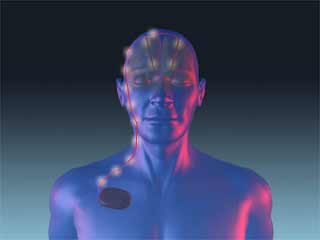
this
animations is available on
request as simple JPG numbered files that you can import in
After-Effects, Combustion or other editing softwares
 -
-| From Wikipedia, the free encyclopedia Insertion of electrode during parkinson surgery Deep brain stimulation (DBS) is one of a group of treatments involving surgical implantation of a medical device called a brain pacemaker, which sends electrical impulses to specific parts of the brain. This surgical procedure is used to treat severe essential tremor and tremor, rigidity and bradykinesia (slow movement) associated with Parkinson's disease, as well as primary dystonia and other conditions. Brain pacemakers were approved by the Food and Drug Administration (FDA) in 1997 as a treatment for Parkinson's disease as well as essential tremor [1] [2], and in April 2003 as a treatment for primary dystonia [3]. In March 2005, the results of a Canadian study performed by doctors from the University of Toronto were published indicating that DBS may also alleviate symptoms in patients suffering from treatment-resistant clinical depression. Procedure The surgery involves craniotomy for implantation of an electrode into the subthalamic nucleus or basal ganglia of the brain. The electrode is powered by a battery-operated neurostimulator typically placed under the collar bone. A connecting wire of platinum and iridium, insulated with polyurethane, conducts signals from the neurostimulator, which is hermetically sealed in a titanium housing. Electrical stimulation through the electrode interferes with neural activity at the target site (usually specific areas of the thalamus or the subthalamic nucleus and pallidum of the basal ganglia) which can alleviate tremors, rigidity or bradykinesia. The choice of target site depends on the symptoms being addressed. After the surgery is completed, an expert calibrates the unit in order to maximize its effectiveness. The programming of the neurostimulator can take up to a year to achieve an optimal setting. Typically DBS is performed unilaterally on the side of the brain opposite to the side of the body most debilitated by the disease, but in many cases it is performed bilaterally in a single operation. |